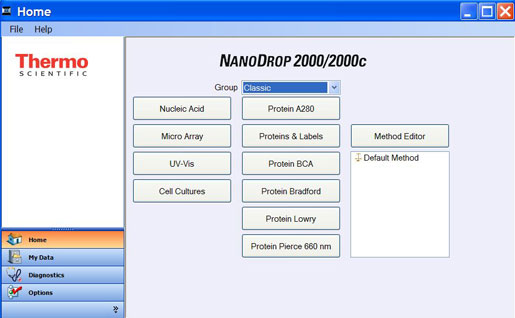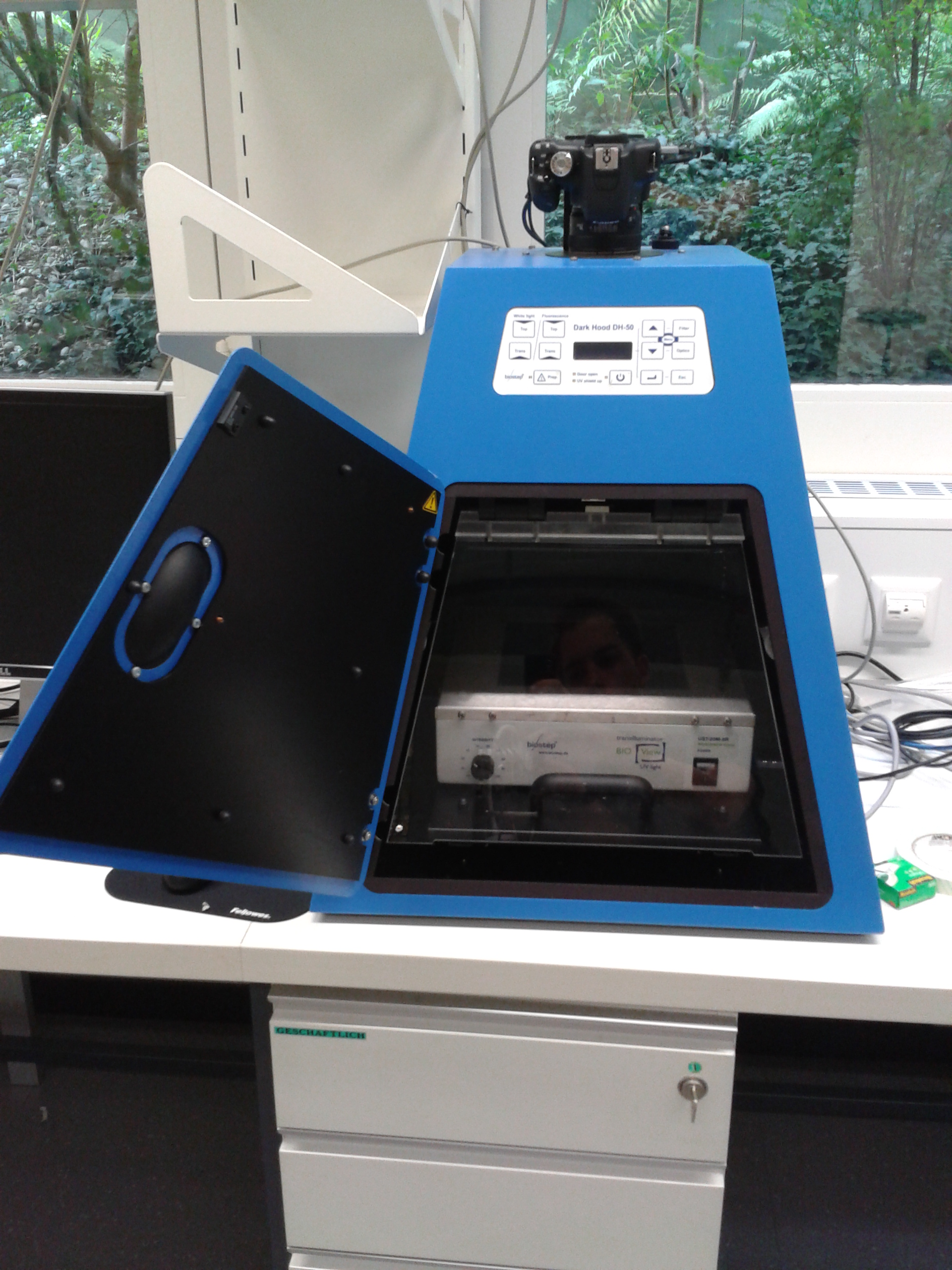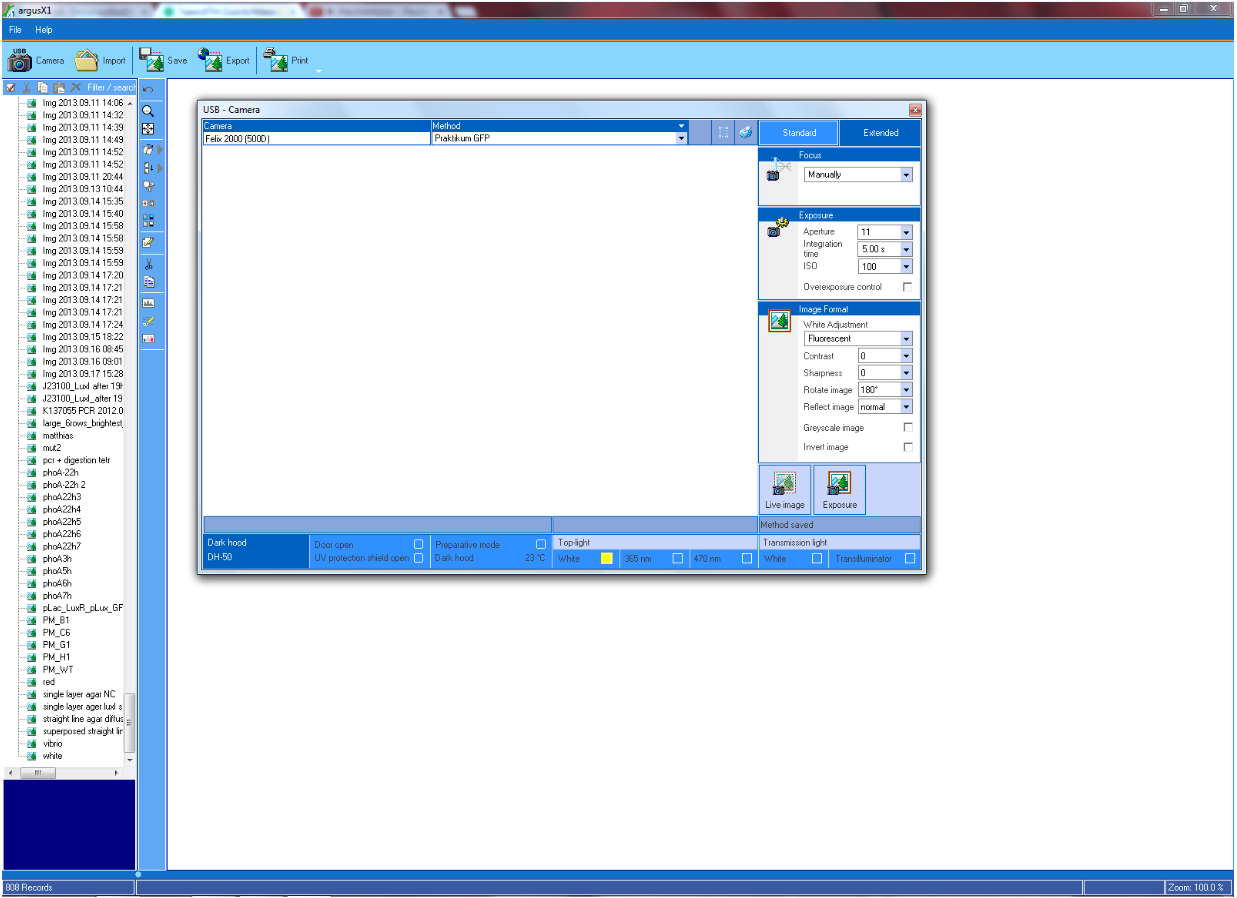Team:ETH Zurich/Materials 2
From 2013.igem.org
| Line 194: | Line 194: | ||
<html><a id="Chromogenic subtrates" class="frog"></a></html> | <html><a id="Chromogenic subtrates" class="frog"></a></html> | ||
<p><b>Chromogenic substrates</b></p> | <p><b>Chromogenic substrates</b></p> | ||
| + | |||
| + | <table style="float:left;margin-top:10px;font-size:12px;font-family:verdana"> | ||
| + | <tr> | ||
| + | <th width="200px" >Substrate</th> | ||
| + | <th width="100px" >Hydrolase</th> | ||
| + | <th width="125px" >Color, <br>Absorption λ<sub>max</sub></th> | ||
| + | <th width="100px" >CAS Number</th> | ||
| + | <th width="150px" >Supplier<br>Product Number</th> | ||
| + | <th width="100px" >Stock</th> | ||
| + | <th width="75px" >Liquid culture</th> | ||
| + | <th width="75px" >Colonies</th> | ||
| + | </tr> | ||
| + | <tr> | ||
| + | <td>5-Bromo-4-Chloro-3-indoxyl-β-D-galactopyranoside (X-Gal)</td> | ||
| + | <td>LacZ | ||
| + | </td> | ||
| + | <td>Blue,<br>615 nm</td> | ||
| + | <td>7240-90-6 | ||
| + | </td> | ||
| + | <td>Biosolve<br>07102350</td> | ||
| + | <td>0.5 M in DMSO</td> | ||
| + | <td>1 mM</td> | ||
| + | <td>50 mM</td> | ||
| + | </tr> | ||
| + | <tr> | ||
| + | <td>N-Methyl-3-indolyl-β-D-galactopyranoside (Green-Gal)</td> | ||
| + | <td>LacZ | ||
| + | </td> | ||
| + | <td>Green,<br>665 nm</td> | ||
| + | <td>207598-26-3 | ||
| + | </td> | ||
| + | <td>Sigma-Aldrich<br>67610</td> | ||
| + | <td>0.1 M in DMSO</td> | ||
| + | <td>1 mM</td> | ||
| + | <td>50 mM</td> | ||
| + | </tr> | ||
| + | <tr> | ||
| + | <td>6-Chloro-3-indolyl-β-D-glucuronide (Salmon-Glc)</td> | ||
| + | <td>GusA | ||
| + | </td> | ||
| + | <td>Salmon,<br>540 nm</td> | ||
| + | <td>138182-20-4 | ||
| + | </td> | ||
| + | <td>Sigma-Aldrich<br>24907</td> | ||
| + | <td>10 mM in DMSO</td> | ||
| + | <td>0.05 mM</td> | ||
| + | <td>5 mM</td> | ||
| + | </tr> | ||
| + | <tr> | ||
| + | <td>4-Nitrophenoyl-phosphate (pNPP)</td> | ||
| + | <td>PhoA | ||
| + | </td> | ||
| + | <td>Yellow,<br>405 nm</td> | ||
| + | <td>68189-42-4 | ||
| + | </td> | ||
| + | <td>Sigma-Aldrich<br>N3254</td> | ||
| + | <td>0.5 M in DEA</td> | ||
| + | <td>50 mM</td> | ||
| + | <td>0.5 M</td> | ||
| + | </tr> | ||
| + | <tr> | ||
| + | <td>5-Bromo-4-Chloro-3-indolyl phosphate (BCIP)</td> | ||
| + | <td>PhoA | ||
| + | </td> | ||
| + | <td>Blue,<br>615 nm</td> | ||
| + | <td>102185-33-1 | ||
| + | </td> | ||
| + | <td>Sigma-Aldrich<br>B6149</td> | ||
| + | <td>0.1 M in H<sub>2</sub>O</td> | ||
| + | <td>1 mM</td> | ||
| + | <td>50 mM</td> | ||
| + | </tr> | ||
| + | <tr> | ||
| + | <td>5-Bromo-6-Chloro-3-indoxyl butyrate (Magenta butyrate) | ||
| + | </td> | ||
| + | <td>Aes</td> | ||
| + | <td>Magenta,<br>565 nm</td> | ||
| + | <td>873295-29-5 | ||
| + | </td> | ||
| + | <td>Acros<br>34037</td> | ||
| + | <td>20 mM in Acetone</td> | ||
| + | <td>0.1 mM</td> | ||
| + | <td>20 mM</td> | ||
| + | </tr> | ||
| + | |||
| + | <tr> | ||
| + | <td>5-Bromo-6-Chloro-3-indoxyl caprylate (Magenta caprylate) | ||
| + | </td> | ||
| + | <td>Aes</td> | ||
| + | <td>Magenta,<br>565 nm</td> | ||
| + | <td>873295-29-5 | ||
| + | </td> | ||
| + | <td>Sigma-Aldrich<br>53451</td> | ||
| + | <td>0.2 M in Acetone</td> | ||
| + | <td>1 mM</td> | ||
| + | <td>0.2 mM</td> | ||
| + | </tr> | ||
| + | <tr> | ||
| + | <td>5-Bromo-4-Chloro-3-indoxyl-N-acetyl-β-D-glucosaminide (X-GluNAc) | ||
| + | </td> | ||
| + | <td>NagZ</td> | ||
| + | <td>Blue,<br>615 nm</td> | ||
| + | <td>B-7000 | ||
| + | </td> | ||
| + | <td>Biosynth<br>4264-82-8</td> | ||
| + | <td>0.1 M in DMSO</td> | ||
| + | <td></td> | ||
| + | <td></td> | ||
| + | </tr> | ||
| + | <tr> | ||
| + | <td>4-Nitrophenyl- N-acetyl-β-D-glucosaminide (pNP-GluNAc) | ||
| + | </td> | ||
| + | <td>NagZ</td> | ||
| + | <td>Yellow,<br>405 nm</td> | ||
| + | <td>3459-18-5 | ||
| + | </td> | ||
| + | <td>Sigma-Aldrich<br>N9376</td> | ||
| + | <td>15 mM in H<sub>2</sub>O</td> | ||
| + | <td>0.01 mM</td> | ||
| + | <td>15 mM</td> | ||
| + | </tr> | ||
| + | |||
| + | </table> | ||
<br clear="all"/> | <br clear="all"/> | ||
{{:Team:ETH_Zurich/templates/footer}} | {{:Team:ETH_Zurich/templates/footer}} | ||
Revision as of 13:25, 24 October 2013
Thermo scientific NanoDrop™ 2000 spectrophotometer
In order to measure the concentrations of our plasmids after the Miniprep we used the NanoDrop® 2000 spectrophotometer:
NanoDrop™ 2000
UV-Vis Spectrophotometer
Smart. Simple. Robust.
The NanoDrop 2000 is a microvolume spectrophotometer for measuring DNA, RNA, and protein. Using the patented sample retention system* the NanoDrop 2000 accurately measures samples as small as 0.5 µL, and reports sample concentration, purity ratios, and full spectral data.
Full spectral microvolume UV-Vis analysis:
Fast measurement time of less than 5 seconds – just pipette, measure, and wipe clean
Measure 0.5 - 2 µL DNA, RNA, and protein samples
Software includes pre-configured methods for measuring nucleic acids, Protein A280 and colorimetric assays, and flexible customized methods
Measure concentrations up to 15,000 ng/µl (dsDNA) - eliminating the need for dilutions
Low-cost operation – no plates or other consumables
Perfect for proteins with low wavelength absorbance, such as peptides at 205 nm
Classic NanoDrop™ Applications
Nucleic Acid
Protein A280
Micro Array
Proteins & Labels
BCA, Bradford, Lowry,
Pierce 660 nm
UV-Vis
Cell Cultures
plus Diagnostics
New Applications
User defined custom methods
New and updated
Intuitive user interface
Flexible reporting & data export
Oligo calculator, units flexibility & more
[http://www.nanodrop.com/Productnd2000overview.aspx References]
Tecan Infinite M200 Pro™ and the Tecan iControl™ software
The fluorescence measurement were perfomed using the Infinite M200 Pro :
Multimode microplate readers for infinite application flexibility and high-level of performance
The Infinite 200 PRO is a user-friendly and affordable multimode reader, designed to cater for the needs of today’s applications. Based on the highly successful Infinite 200 series of microplate reader, the Infinite 200 PRO can provide a full range of leading detection methods in one easy-to-use modular instrument, with either Quad4 monochromator™ or filter-based technologies. Users can select the desired modules to create the perfect reader for their needs, with the option to upgrade as requirements change. The Infinite 200 PRO offers excellent sensitivity, multiplexing capabilities and high format flexibility, including 6- to 384-well microplates, PCR plates, cuvettes and Tecan’s patented NanoQuant Plate™ for low sample volumes.
For uncompromised performance in all detection modes, the Infinite 200 PRO uses advanced optics and high-performance detectors, optimized for the requirements of fluorescence, luminescence and absorbance reading. The Infinite 200 PRO offers a wide range of detection modes, including:
Fluorescence intensity (top and bottom reading) (UV – NIR & wavelength scanning)
Fluorescence resonance energy transfer (FRET)
Time resolved fluorescence energy transfer (TR-FRET) like HTRF®
Time resolved fluorescence (TRF)
Fluorescence polarization (FP)
Flash luminescence
Glow luminescence
Dual-color luminescence (including BRET 1 & BRET 2 applications)
Absorbance (UV – NIR & wavelength scanning)
AlphaScreen® and AlphaLISA® technology
Injectors system for up to two reagents
Temperature control
Small sample measurement in NanoQuant Plate
i-control™ – Microplate Reader Software
The Infinite® series of Tecan readers (Infinite 200, Infinite F500 and Infinite M1000) comes complete with i-control, the easy-to-use microplate reader software. It allows the user to define the workflow for each application. Each workflow is easily created by dragging and dropping the processing steps into a sequence according to the assay protocol. The application workflow is then visible to the user and can be saved for future use. Data are easily managed and exported to Windows® compatible formats (Excel®).
Intuitive
Easy set up of workflows via drag & drop
Workflows are visible to the user
Workflows may be saved as measurement scripts
On-line data presentation in Excel®
Graphical definition of measurement range
Plate definition editor
Enhanced data management
Export of data into user-defined Excel® templates
Flexible
User sets up the workflow to suit his own application
Multilabel measurements for multiplexed assays
Different kinds of kinetic measurements
Supports ratio mode also for well kinetic measurements
[http://www.tecan.com/platform/apps/product/index.asp?MenuID=1812&ID=1916&Menu=1&Item=21.2.10.1 References]
Amersham Biosciences Novaspec Plus™
All our Optical Density at wavelength 600nm were determined using the Novaspec Plus™
Novaspec Plus™ Visible Spectrophotometer
Novaspec™ Plus Visible Spectrophotometer is ideal for general
biotech laboratory use. There are stored methods for the standard colorimetric methods of Bradford, BCA, Biuret and Lowry in addition to the basic modes of absorbance, transmittance,OD600 and concentration measurements. The use of diode array technology permits rapid wavelength scans to be made as well and, as there are no moving parts, make for a highly reliable and low maintenance product (Fig 1).
The large backlit display enables the graphical results for wavelength scans, kinetics assays (including slope calculation for rate/activity studies) and standard curves to be viewed (Fig 2).Up to 99 methods for such experiments can be stored for instant recall and use by a laboratory assistant. Novaspec Plusis delivered with Grafico, a PC utility software package, and the requisite serial lead, providing the user with the means to capture, print and store data from the instrument (with a time/date stamp) onto a PC so that a results log can be built up or data exported to Microsoft™ Excel.
The cell holder supplied with Novaspec Plus accepts standard 10-mm pathlength glass or plastic cells (adapters are availableto convert it to accept 10-, 12- and 16-mm diameter test tubes).It can be removed for cleaning, or flushed through with water in situ, if spillages occur.
For users who require thermostatting, particularly for kineticsstudies and use with test kits, a special version of Novaspec Plus is available with a factory fitted heated cell holder (37 °C only);note that this cell holder cannot be added retrospectively.
Features
“Flash Scan” diode array
Stored protein methods
Bacterial cell culture measurement at OD600
Kinetics for activity studies
Stored methods
[http://www.heraco.se/images/user/PDF/Novaspec%20Plus.pdf References]
Biostep Dark-Hood DH-50 and the Argus-X1™ software
The images of the plates for AHL diffusion, GFP expression tests, hydrolase conversion on the agar plate were established by the DH-50™ and recorded with the Argus-X1™ software
Dark Hood DH-50 with control panel and display
with sliding table, UV protection shield, CCD
stationary dark hood with large door
sliding table to put on a transilluminator* incl. UV protection shield – no additional protection necessary
special bracket for CCD camera
footprint (WxD) 55x48cm
height incl. camera bracket: 88cm
max. filter size of transilluminator 30x23cm
dimmable white top-light by LEDs
automatic UV cut-off when opening the UV protection shield
preparative function enables observation of gels under UV light
control panel with keypad and LCD display
3 USB ports
Functionality:
transilluminator: on/off
white top-light: on/off, dim function
preparative function
optionally available: control of zoom, aperture and focus by motor zoom objective
optionally available: storage of application methods repeatable
transilluminators with dimensions (W x D x H): 32.5 x 32.2 x 10.5cm; corresponds to the series of biostep UST, USDT, UXFT, BST, GST, YST, RST, WST
Optionally upgradeable with UV protection shield, filter wheel, white transmission light, UV or epi light in the visible range
[http://www.biostep.de/i18n_en/products/Bio_Imaging_components_1776/Tripod__dark_hoods_and_accessories_1863/Dark_hoods_1865/Dark_Hood_DH_50_6/index.html References]
biostep argusX1™ basic licence
PC-software for controlling the camera basic modules Felix 1000/2000, 5000/6000/7000 and the transmission scanners of the series ViewPix 900/1300
Attention:
Imperatively necessary: module for controlling the camera or scanner!!!
General software functions:
integrated database for administration of the images
copying and cropping of single images or group images within a database or even between database to database if the additional module Project administration exists
deletion of single images or group images
functions for image processing incl. Undo
rotating in arbitrary angles and around 90°, 180°
reflecting in horizontal and vertical direction
inverting
cropping
various filter functions
marking of the images with text, rectangle and line
automated generation and numeration of sample names after the acquisition
memo function: input of a note for each image and printout of the same on a protocol
history for documentation of the acquisition parameters for each image
overexposure control
data export into other Windows applications
data import of images in different formats
creation of individual print reports
quick print
selection of the export format, export path, print report for quick print
control of the functions a of biostep transilluminators with PC interface
[http://www.biostep.de/products/Bio_Imaging_software_1843/Acquisition_and_control_software_1844/argus_X1___for_cameras_and_scanners_1845/biostep_argusX1__basic_licence_1/index.html References]
BD LSRFortessa™ Flow Cytometer System and the FACSDiva™ and FlowJo™ software
In order to determine the exact sensivity shift and expression level of GFP with the mutated promoters the BD LSRFortessa™ Flow Cytometer System was used for the measurement,FACSDiva™ for the recording of the data and the FlowJo™ software for the data analysis.
BD LSRFortessa™ Flow Cytometer System
The BD LSRFortessa™ cell analyzer offers the ultimate in choice for flow cytometry, providing power, performance, and consistency.
Designed to be affordable and expandable, the BD LSRFortessa has the flexibility to support the expanding needs of multicolor flow cytometry assays.The BD LSRFortessa analyzer can be configured with up to 4 lasers—
blue, red, violet, and UV—which enables the detection of up to 18 colors simultaneously. The BD LSRFortessa may be upgraded subsequently with additional or new lasers from BD, as future requirements dictate.Innovative Designs for Optical Efficiency Built on a proven platform, BD LSR analyzers feature innovative designs for both the excitation optics and collection optics that reduce excitation losses and improve light collection efficiency. The result is optical efficiency that delivers maximum sensitivity and resolution for multicolor applications by reducing excitation laser light loss, and improved fluorescent signal collection.Special Order Research ProgramFor research needs at the leading edge of biomedical discovery, the BD LSRFortessa special order research program offers the latest innovations in laser technology to researchers to enable future upgrades with new excitation, wavelength, and power choices. The program lets customers fully customize configurations to deliver added flexibility and power to support advanced research.
Technical and Application Support
As with all BD instruments and reagents, highly qualified BD technical and
application support personnel are available for help in streamlining research and maintaining optimal instrument performance.
[http://www.bdbiosciences.com/documents/bd_lsrfortessa_brochure.pdf References]
FACSDiva™ Software
BD FACSDiva™ software is a collection of rich tools for flow cytometer and application setup, data acquisition, and data analysis that help streamline flow cytometry workflows for today’s busy laboratory.
BD FACSDiva software provides new features to help users integrate flow systems into new application areas, including index sorting for stem cell and single-cell applications, as well as automation protocols for high-throughput and robotic laboratories.
[http://www.bdbiosciences.com/instruments/software/facsdiva/ References]
FlowJo™ Software
FlowJo is a software package for analyzing flow cytometry data. Files produced by modern flow cytometers are written in the Flow Cytometry Standard format with an .fcs file extension. FlowJo will import and analyze cytometry data regardless of which FACS (Fluorescence Activated Cell Sorting) machine is used to collect the data.
[http://www.flowjo.com/ References]
Chromogenic substrates
| Substrate | Hydrolase | Color, Absorption λmax |
CAS Number | Supplier Product Number |
Stock | Liquid culture | Colonies |
|---|---|---|---|---|---|---|---|
| 5-Bromo-4-Chloro-3-indoxyl-β-D-galactopyranoside (X-Gal) | LacZ | Blue, 615 nm |
7240-90-6 | Biosolve 07102350 |
0.5 M in DMSO | 1 mM | 50 mM |
| N-Methyl-3-indolyl-β-D-galactopyranoside (Green-Gal) | LacZ | Green, 665 nm |
207598-26-3 | Sigma-Aldrich 67610 |
0.1 M in DMSO | 1 mM | 50 mM |
| 6-Chloro-3-indolyl-β-D-glucuronide (Salmon-Glc) | GusA | Salmon, 540 nm |
138182-20-4 | Sigma-Aldrich 24907 |
10 mM in DMSO | 0.05 mM | 5 mM |
| 4-Nitrophenoyl-phosphate (pNPP) | PhoA | Yellow, 405 nm |
68189-42-4 | Sigma-Aldrich N3254 |
0.5 M in DEA | 50 mM | 0.5 M |
| 5-Bromo-4-Chloro-3-indolyl phosphate (BCIP) | PhoA | Blue, 615 nm |
102185-33-1 | Sigma-Aldrich B6149 |
0.1 M in H2O | 1 mM | 50 mM |
| 5-Bromo-6-Chloro-3-indoxyl butyrate (Magenta butyrate) | Aes | Magenta, 565 nm |
873295-29-5 | Acros 34037 |
20 mM in Acetone | 0.1 mM | 20 mM |
| 5-Bromo-6-Chloro-3-indoxyl caprylate (Magenta caprylate) | Aes | Magenta, 565 nm |
873295-29-5 | Sigma-Aldrich 53451 |
0.2 M in Acetone | 1 mM | 0.2 mM |
| 5-Bromo-4-Chloro-3-indoxyl-N-acetyl-β-D-glucosaminide (X-GluNAc) | NagZ | Blue, 615 nm |
B-7000 | Biosynth 4264-82-8 |
0.1 M in DMSO | ||
| 4-Nitrophenyl- N-acetyl-β-D-glucosaminide (pNP-GluNAc) | NagZ | Yellow, 405 nm |
3459-18-5 | Sigma-Aldrich N9376 |
15 mM in H2O | 0.01 mM | 15 mM |
 "
"












